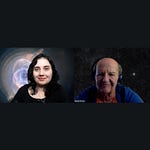Watch Ryan Haecker and Anna K. Winters at Ætheria Symposia I, recorded Saturday, 28th June from the island of Crete. They take you on a pilgrims journey from Teilhard de Chardin’s techno-mystical vision of the hyperpersonality at the center of our world to Simone Weil’s modern re-activation of ancient insights.
Abstract
The Ideon Cave in Crete carries a memory of the first apocalyptic passage of the gods that portends each technical recreation of the world. Hesiod tells of how the goddess Rhea “hid [Zeus] in a remote cave beneath the secret places of the holy earth”, before Zeus led the Olympian gods to overthrow the old king Cronos and cast out the Titans. In the Statesman (269c-274d), Plato presents a new version of this myth, in which the ‘Divine Pilot’ (Theios Kybernētēs) rationally controls a cosmic “living creature” (Anima Mundi), “endowed with reason” by the divine Mind (Nous), and “framed” by the architecture of celestial mechanics. The collapse of this cybernetic system - from the first age of Cronos, when “God was supreme governor”, to this subsequent age of Zeus, when “the pilot of the ship of the universe” has “let go the handle of its rudder” - results in the “cosmic crisis” of mortality, and of an intergenerational loss of memory, which requires - as both a remedy and poison - Prometheus to steal the gift of fire, and Haphaestus to invent technology. Yet, as Plato warns (Phaedrus, 274b–279b), the invention of writing, as an external aid to memory (hypomnēsis), can, in contrast to living recollection (anamnēsis), also become an occasion for increased forgetting, and, in our age of digital computer writing, for the compounding meta-crises that afflict modernity.
Drawing on Diotima’s speech in Plato’s Symposium (201e-205e), Simone Weil developed a theory of mediation as the aesthetic self-limitation of cycles of destructive force, which she observed reaching their height in the technical-bureaucratic apparatuses of the 20th century. While the erotic foundations of beauty are always structured around a lack, Weil calls for this lack to be oriented again towards its fulfillment in agapeic transcendence, which is preserved through a mystical decreation of our narcissistic imaginations, and which becomes ever-more concrete through an incarnational mediation of sacred harmonic and geometric correlations. Drawing, in a similar way on Henri Bergson’s ‘creative evolution’, Teilhard de Chardin prophesied that the evolution of technical nature would culminate in the ‘Omega-point’ reversal of thermodynamic entropy, an ever-more ecstatic growth in the ‘Noosphere’ of celestial intelligence, and in the ultimate overcoming of Plato’s ‘cosmic crisis’ through a free recognition of the ‘hyperpersonality’ that abides at the center of cosmotechnics and every cybernetic system.




